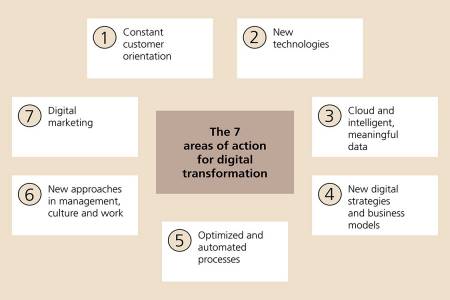What are the priorities for small Swiss companies with regard to their digital transformation and what particular challenges and opportunities do these areas of action present? Marc K. Peter, Head of the Competence Center for Digital Transformation at the University of Applied Sciences and Arts Northwestern Switzerland (FHNW) and publisher of the “KMU-Transformation” (SME transformation) study, provides the answers.
You are here:
Where should I use digitization? These are the seven areas of action
In which areas is digital transformation taking place? These are the seven areas of action which you should be discussing in your small company.


-
According to the kmu-transformation.ch study (German), over half of small Swiss companies are faced with changing customer requirements due to their digital transformation. Cost pressure is also increasing. To remain competitive, companies are focusing more intensively on constant customer orientation in the age of digitalization, enabling them to develop new strategies and solutions, such as personalized products.
Opportunities
In the constant customer orientation area of action, small businesses can play to their particular strengths – customer proximity, simple decision-making processes and, in many cases, the vast expertise of long-serving employees.
Challenges
The challenge is finding time for discussions with customer groups and to develop and implement new products and services.
-
On the one hand, the Swiss companies surveyed use new technologies to improve products and services or to develop new ones. This includes the use of sensors, robotics, mobile and voice-controlled applications and the integration of their products into the Internet as part of Industry 4.0 or the Internet of things. On the other hand, they work with new technologies to make in-house communication and cooperation more efficient, dynamic and effective. To achieve this, they use apps and online platforms.
Opportunities
The new technologies make it possible to implement new ideas, integrate new applications and exploit new market opportunities. Many such technologies, e.g. apps or open source solutions from the Internet which can be used and modified freely, can easily be trialled, sometimes free of charge.
Challenges
The challenge is being aware of these new technologies and understanding them. This can be achieved provided small businesses prioritize the issue, invest the time required and take part in initiatives, such as exchanging ideas with technology centers in the region, or remaining informed about professional events.
-
In the field of information technology (IT), the companies surveyed indicated that they most frequently invest in cloud solutions. Their aim is to optimize data management and storage and to make company and customer information accessible from any location. Using cloud solutions, companies can also set up large databases to develop new digital business models, products and services or to obtain knowledge of smart data for Industry 4.0.
Opportunities
Cloud solutions allow small companies to inexpensively establish flexible IT infrastructures, which were previously only available to large companies. Analysis software enables data collected in the cloud to be evaluated and used for the development of new products and services.
Challenges
To set up and manage cloud solutions, small businesses require technical expertise which they can acquire either by engaging partners or through staff training. IT security measures must also be defined and implemented.
-
Depending on the sector, companies may be obliged to adapt their strategy and business model to the digital world. Companies have various options available to them, from redefining their strategy completely or expanding their range of products and services with a digital element, through to making gradual improvements by digitizing and automating internal processes or offering new digital sales channels.
Opportunities
Digital transformation is spurring companies on to develop innovative digital strategies and business models. Within a short space of time, small companies can try out lots of new things and use existing and sometimes global online platforms.
Challenges
The challenge lies in changing, breaking up and shifting away from existing strategies and thought patterns. Probably the greatest risk in this area of action is not taking any risks at all.
-
The study indicated that the main driver for digital transformation is more efficient processes – this takes top priority for 83% of the SMEs surveyed. The focus is being placed – including at small businesses now – on documenting and describing processes to then identify optimization potential.
Opportunities
The web-based technologies available such as online platforms, apps and software solutions mean there is great potential for more streamlined, digitized and automated processes.
Challenges
If processes are to be made more efficient, IT requirements must be defined with better structured process documentation in order to identify the most useful technologies. It is therefore necessary to take a holistic view. There is no point in digitizing a process and then discovering that the information required is still not available.
-
Over two-thirds of the SMEs surveyed indicated that their digital transformation is having an impact on their corporate culture. Companies have to promote a willingness to change and to get to grips with future-oriented management principles and ways of working.
Opportunities
The size of small companies means they have incredibly high potential in terms of making their team more powerful and dynamic. Modern management and cooperation can be used to support innovation, creativity and agility to a high degree. In an ideal scenario, a modern company’s framework conditions should be devised together with employees. The question of which skills staff should possess in future should also be addressed.
Challenges
Unfortunately, this field of action is often overlooked due to the hectic nature of daily business. The issue must be tackled proactively and managed over the course of the year, for example through half-yearly meetings with employees and ongoing training activities.
-
Digital marketing enables small businesses to achieve much more efficient market development. They can use digital marketing platforms and channels to communicate with their customers and conclude transactions more easily. On the one hand, this covers new digital forms of advertising, such as search engine, e-mail and social-media marketing. On the other hand, sales and service activities are incorporated into the process to achieve a more consistent and efficient communication and sales process.
Opportunities
On the one hand, small companies can use content marketing – creating their own content via their social media channels – to set up an online presence inexpensively, ensuring that their website features prominently in search engine results. On the other hand, they can increase sales cost-effectively through marketing automation (platforms which automate all customer communications) and e-commerce solutions.
Challenges
Taking advantage of the opportunities presented by digital marketing requires expertise. It is generally a good idea to collaborate with external partners such as IT companies and communications experts. Small companies must also dedicate a relatively large amount of time – particularly in the early stages – to data preparation (e.g. customer data and product information), content creation and setting up IT systems such as customer and product databases or e-commerce solutions.
Liste di controllo e ulteriori informazioni
- Checklist for the seven areas of action (PDF, German)The link will open in a new window
- Implementing digital transformation projects in seven stages (PDF, German)The link will open in a new window
- Download free copy of the SME transformation study at kmu-transformation.ch (German)The link will open in a new window
- Download Canvas for SME workshops on digital transformation at digital-transformation-canvas.net (German)The link will open in a new window
- Maggiori informazioni sul marketing digitale
About our expert
Prof. Dr Marc K. Peter is Head of the Competence Center for Digital Transformation in the School of Business at the FHNW (University of Applied Sciences and Arts Northwestern Switzerland) in Olten. This provides research, consulting and training services and supports organizations with developing and implementing digital growth strategies. In addition to his role as a lecturer and course leader, Dr Marc K. Peter also launched and runs the “Digital transformation for SMEs” project. Before taking up his current role at the FHNW, Dr Peter held management positions at various companies in the fields of strategy, technology, sales and marketing in Europe and in the Asia-Pacific region.

